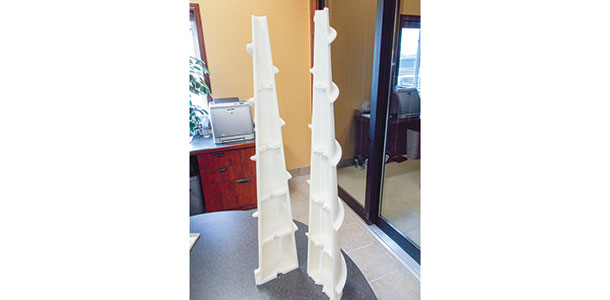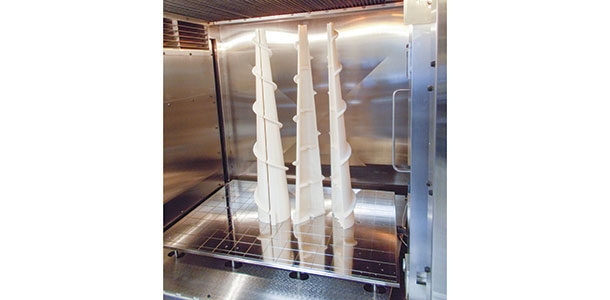So Farmer A took a piece of wood, sanded it down and made a really crude-looking wear point to attach to the corn-head snout, which would pick up the stalk enough to feed it into the chopper. Then he took his makeshift attachment to an equipment company to see if they could make several of them for his corn snouts.
The equipment company told him the tooling for an injection-molded part for what he would need would run about $50,000. Farmer A couldn’t afford that. But the equipment company had a 3-D printer and offered to use a 3-D scanner to scan his part and “print” it for him using thermoplastics.
The thermoplastic resin would be stout enough, eliminate the tooling cost and would allow him to finish his harvest. The 3-D printing project would cost him about $1,000. Farmer A couldn’t afford not to take advantage of that, and one more corn crop was saved.
Farmer B was trying to improve his silage chopping to annihilate the corn kernels.
So he designed a blade attachment to mount inside the chopper which would give additional kernel processing. He created some crude prototypes himself and took his design to an equipment company to see if they could produce it for him. The equipment company had a 3-D printer.
They took his design, printed it, added an attachment piece and mounted a professionally engineered and laser-cut blade to it. And just like that, Farmer B improved the quality of his silage, which in turn resulted in higher milk production and increased his milk check. His project cost was about $1,500.
These examples feature real farmers with real problems. 3-D printing has been around for 27 years, but until 2012 it was available only for aerospace and medical applications. In 2012, GVL Proto Poly, a rotational molding manufacturer in Litchfield, Minnesota, purchased a 3-D printer for use with their ag clientele.

The 3-D printer supply company was skeptical; this process hadn’t been used in agriculture before. While 65 percent of the company’s business is producing parts for original equipment manufacturers, the other 35 percent is generated from individuals like Farmer A and Farmer B – people who have a need and a mind for solutions.
“If one farmer comes in looking for a solution, he’s not the only one with the problem. So if a guy has an idea to modify a piece of equipment, he can come sit down with us and we’re all ears,” says President and CEO Allan Cronen. In addition to providing a single-customer solution, oftentimes the farmer’s project is one that can be developed for a broader audience.
Cronen actively looks for agricultural applications for the printer. He travels to 20-plus states in a year, spending two to three days at each location on a farm-show circuit to directly interact with farmers, listening to them and talking about products and solutions to design and develop. “That’s our ear on the railroad track,” Cronen says.
Usually, a part is first engineered or drafted using 3-D software or 3-D CAD system. It is then printed with nylon or low-density polyethylene through a layering process, which can take a few hours or a few days. Or the process can be reversed, where an object or part can be scanned with a 3-D scanner, entered into the 3-D printer software system, then printed. Either way, the part is production-ready.
“It’s changing the way we do business,” says Cronen. “3-D printing is endless. Whatever you can draft and design on a 3-D drafting program or 3-D CAD, you can print; it’s just that simple.”
While custom parts are an important segment of the business, the company also offers a catalog of parts. However, if a farmer breaks down and finds his equipment dealer can’t get the part shipped in a timely fashion, that doesn’t necessarily mean the farmer can obtain a part by simply having it 3-D printed. If a part is protected by a patent or intellectual property rights, it can limit the ability to print a replacement part.
The good news is: With this technology, re-shoring jobs in the U.S. is happening more and more, especially in agriculture, as processes are developed that make U.S. manufacturing price competitive – not to mention the shortened lead times with in-states manufacturing rather than having a part manufactured in China with a 16-week lead time.
When will this technology be available for individual farmers? On a small scale for small parts, it already is. There are 3-D printers that print metal, for example, and also 3-D printers that print plastic. There are desktop printers that are under $2,000 currently; the problem is they don’t yet have the accuracy, and they don’t have the printing envelope size at that price point.
The size of these printers is generally relegated to a modest 8-inch cube size – not necessarily practical for many agricultural equipment parts. GVL Proto Poly’s printer is 36 inches x 24 inches x 36 inches, and with its support equipment takes up a nice-sized room. The equipment and setup cost for the company was substantial with just the Faro scanning arm, the 3-D scanner, a granite countertop and large cabinet, with the support equipment.
While the larger printer with support setup isn’t a cost-effective investment for individual farmers, Cronen predicts that 3-D printing and scanning will experience the same revolution that home computers did, eventually becoming affordable for many. However, the knowledge and experience with 3-D software might still pose challenges for the average agricultural operation.
Nonetheless, for agricultural equipment manufacturers, this technology has enabled them to introduce new products, including design, development and tooling, in only nine months. Without a 3-D printer, that wouldn’t have happened.
On a broader scale, it certainly could portend small start-up company challenges to big business. With this technology, any kid on a farm with the next big idea could launch an idea into the marketing world right from his living room. FG
PHOTOS
This 3-D printed short auger is used to pick up downed corn on the fender of a corn head. The parts were printed in two pieces so a steel shaft could be installed into the printed part, allowing testing of fit and function before tooling was ordered. Photos courtesy of Nathan Hulstein.












